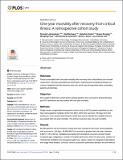One-year mortality after recovery from critical illness: A retrospective cohort study
Author(s)
Stone, David J.; Lokhandwala, Sharukh; McCague, Ned J; Chahin, Abdullah; Escobar Restrepo, Braiam; Feng, Mengling; Ghassemi, Mohammad Mahdi; Celi, Leo Anthony G.; ... Show more Show less
Downloadjournal.pone.0197226.pdf (1.439Mb)
PUBLISHER_CC
Publisher with Creative Commons License
Creative Commons Attribution
Terms of use
Metadata
Show full item recordAbstract
Rationale Factors associated with one-year mortality after recovery from critical illness are not well understood. Clinicians generally lack information regarding post-hospital discharge outcomes of patients from the intensive care unit, which may be important when counseling patients and families. Objective We sought to determine which factors among patients who survived for at least 30 days post-ICU admission are associated with one-year mortality. Methods Single-center, longitudinal retrospective cohort study of all ICU patients admitted to a tertiary-care academic medical center from 2001–2012 who survived 30 days from ICU admission. Cox’s proportional hazards model was used to identify the variables that are associated with one-year mortality. The primary outcome was one-year mortality. Results 32,420 patients met the inclusion criteria and were included in the study. Among patients who survived to 30 days, 28,583 (88.2%) survived for greater than one year, whereas 3,837 (11.8%) did not. Variables associated with decreased one-year survival include: increased age, malignancy, number of hospital admissions within the prior year, duration of mechanical ventilation and vasoactive agent use, sepsis, history of congestive heart failure, end-stage renal disease, cirrhosis, chronic obstructive pulmonary disease, and the need for renal replacement therapy. Numerous effect modifications between these factors were found. Conclusion Among survivors of critical illness, a significant number survive less than one year. More research is needed to help clinicians accurately identify those patients who, despite surviving their acute illness, are likely to suffer one-year mortality, and thereby to improve the quality of the decisions and care that impact this outcome.
Date issued
2018-05Department
Institute for Medical Engineering and Science; Harvard University--MIT Division of Health Sciences and Technology; Massachusetts Institute of Technology. Center for Transportation & Logistics; Massachusetts Institute of Technology. Department of Electrical Engineering and Computer ScienceJournal
PLOS ONE
Publisher
Public Library of Science
Citation
Lokhandwala, Sharukh, Ned McCague, Abdullah Chahin, Braiam Escobar, Mengling Feng, Mohammad M. Ghassemi, David J. Stone, and Leo Anthony Celi. “One-Year Mortality after Recovery from Critical Illness: A Retrospective Cohort Study.” Edited by Chiara Lazzeri. PLOS ONE 13, no. 5 (May 11, 2018): e0197226.
Version: Final published version
ISSN
1932-6203